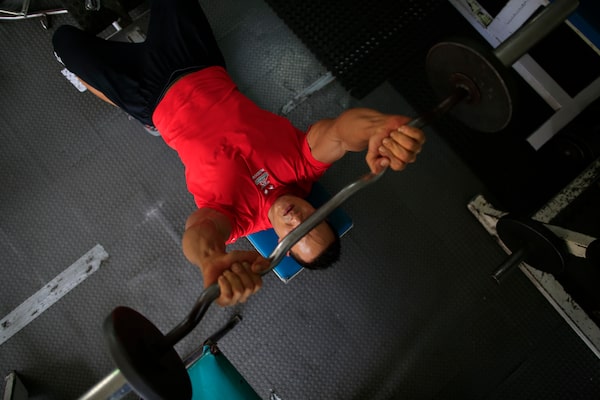
Carlos Suarez lifts weights as part of his daily training regimen ahead of the Pan Am Games in Toluca, Mexico, on June 6, 2019.Rebecca Blackwell/The Associated Press
When you’re forecasting fitness trends, you can’t help feeling that Albert Einstein was right in claiming that the distinction between past, present and future is “only a stubbornly persistent illusion.”
Will 2024 be the year that we harness the power of wearable technology to optimize our high-intensity interval training while incorporating functional body-weight workouts, thus finally achieving perfect health? Nope: That was 2016, if you flip through previous New Year’s prediction columns.
The never-ending loop of fitness fads that cycle in and out of fashion is an indication that the basics of exercise and health don’t change from year to year. But it’s also a reminder that we haven’t yet got it all figured out – and that, as a result, there’s the potential for incremental improvements in the way we pursue our fitness goals.
In that spirit, here are four ideas that will make waves in the fitness world in 2024.
Null studies
French researchers just published a fascinating study testing the idea that foam mattress toppers with high heat capacity might improve sleep quality after hard workouts. The upshot? It didn’t work.
This is great news, because exercise science has a deeply ingrained bias in favour of publishing only positive research results. This generates the hugely misleading impression that pretty much every pill, gadget and novelty mattress cover “work” – because all the negative studies are buried in some professor’s desk drawer.
This is a tricky problem to solve, because it’s simply not that exciting to discover what doesn’t work. But there’s a growing movement in exercise science, and in science more broadly, to commit to publishing results even when they don’t produce sexy surprises.
And really, we should all be delighted to see null results, because they save us from wasting time and money on ineffective workout hacks.
Hybrid athletes

Li Zhongfei/iStockPhoto / Getty Images
Hybrid athletes want to lift heavy weights, run long distances and look like Venice Beach-era Arnold Schwarzenegger. And hey, who wouldn’t?
In sports science circles, researchers have been puzzling for decades over the so-called interference effect that crops up when you try to optimize strength and endurance at the same time. Getting enough nutrition, particularly protein, is part of the solution. So is figuring out how to space out workouts, so that, for example, strength sessions don’t follow endurance sessions too closely.
In its made-for-Instagram form, the hybrid athlete trend is mostly about shilling bespoke supplement lines. But as an aspirational goal, it’s a refreshing change from the culture clash that has traditionally divided muscleheads from endurance freaks. There’s growing evidence that pushing both ends of the spectrum is good for health and longevity – and better yet, the hybrid influencers make it look fun.
Carbohydrates

Kanawa_Studio/iStockPhoto / Getty Images
Don’t call it a comeback, because carbohydrates have remained the main pillar of sports nutrition even during the peak keto years.
But lately, Tour de France cyclists have been pushing their carb intake to new heights, reaching up to 120 grams of carbohydrate an hour – roughly double the maximum that sports nutritionists recommended as recently as a decade ago. Scientists are testing the protocol, and the practice is spreading to other sports like triathlon and ultrarunning.
Scarfing down that many carbs involves training your digestive system and using specially formulated carb mixed, and it’s unnecessary for anyone but elite athletes in extreme endurance events. But it’s a reminder that even the most well-established areas of sports science continue to evolve – and that even recreational marathoners could probably benefit from upping their (typically much lower) in-race carb intake.
Feelings
Kieran Lumb is a numbers guy. The 25-year-old pro runner from Vancouver, who picked up Canadian records in the indoor and outdoor 3,000 metres this year, has an engineering degree plus an M.S. in information systems.
But when he runs, he wears a simple Timex Ironman stopwatch. No GPS, no heart-rate monitor, no Siri.
“It’s taken a while for me to be less neurotic,” he told the New York Times this fall, “but it’s liberating.”
Lumb is not alone. As wearable technology gets smaller, faster and more pervasive, some athletes are embracing a wired future.
But others are charting an alternate course in the belief that tapping into their feelings will give them more insight than any high-tech wearable. And so far, the evidence suggests they’re right.
Alex Hutchinson is the author of Endure: Mind, Body, and the Curiously Elastic Limits of Human Performance. Follow him on Threads @sweat_science.